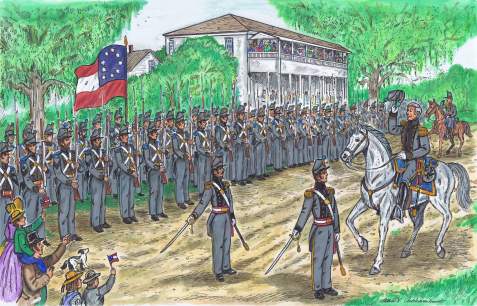Way back a hundred and eighty years ago, at Troupville, GA which was then still the county seat of old Lowndes County, there stood an old cypress tree. This old tree weathered many a Wiregrass storm and its roots held steadfast. Passing under its boughs, pioneer settlers like Levi J. Knight came to Troupville to conduct the governmental, commercial and social affairs of the county. The town was built right in the fork of the Little River and the Withlacoochee. “Troupville only suffered one inconvenience, wrote Montgomery M. Folsom. To get to town three-fourths of the population had either to cross the river of the east or the river of the west and half the time, during the winter and spring, these rivers were raging with freshets, the bridges were afloat and were frequently swept away.”
When the flood of March 1841 inundated the town, the residents noted the high-water level by a mark on the old tree. 
The height of that flood, known as the Harrison Freshet, became the standard by which all subsequent floods were judged for a hundred years thereafter. The flood was associated with William Henry Harrison, who carried the presidency in 1840, in an election which lasted 34 days. Levi J. Knight’s nephew, Henry Harrison Knight, was born November 17, 1840, smack in the middle of the election.
There has come to be some confusion over which flood is properly known as the Harrison Freshet, some histories placing the so-named flood in 1840 and others in 1841. Congressional records state the Harrison Freshet “occurred in 1841, lasting from the 11th of March to the 19th.” Newspapers all over the state of Georgia reported rising waters and washed-out bridges during this period, just days after the inauguration of William Henry Harrison as the ninth President of the United States. But parts of Georgia had also been awash in the flood of 1840, which saw waters rise as high.
The freshet of May [1840] continued while the convention at Milledgeville that nominated General William H. Harrison for the Presidency, was in session, and it was, therefore, called by the people east of the Oconee river the Harrison freshet. In that portion of the country, and beyond the Savannah river and in Carolina, the rivers and streams were higher, and the overflow and destruction greater than by any other freshet since the Yazoo freshet in 1796. The cities of Augusta and Hamburg were submerged.
In the early part of March, 1841, after President Harrison’s inauguration, the big fresh occurred west of the Oconee, and the Ocmulgee, Flint and Chattahoochee rivers, and all other smaller streams, contained more water and produced greater damage than ever known. In this section the last inundation was also called the Harrison freshet; hence the confusion that arose many years afterwards in distinguishing which was the proper Harrison fresh. The discrimination was, however, distinctly recorded at the time of the occurrences. The fresh of May and June, 1840, while the convention was held at Milledgeville, was named by the Democrats, “The Nomination Freshet,” and the fresh of March, 1841, was also named by the same “unterrified” authority “The Harrison Inauguration Freshet.” An iron spike was driven into the western abutment of the city bridge by Mr. Albert G. Butts, denoting the highest water ever in the river down to that time, March, 1841. The spike still remains, and is inspected at every freshet in the Ocmulgee. – Historical Record of Macon and Central Georgia
At Troupville, it was the same; The mark remained on the old cypress tree, and it was inspected at every freshet. The flood of 1897 precipitated such an inspection.
New Orleans Times Democrat
March 28, 1897
Bridges Washed Away and Railroad Traffic Stopped.
Special to the Times-Democrat.
Atlanta, Ga., March 27. – All of the streams running into the largest rivers of Southwest Georgia are flooded to such an extent as to have almost suspended travel on the east and west line of the Plant system, as well as on the Georgia and Alabama Railroad Line. The Georgia Southern Railroad is washed out in many places, and no trains have passed in the last twenty-four hours. In the neighborhood of Valdosta the floods have risen to such an extent as to cover almost the entire country. The Willacoochie rose at the rate of two feet an hour at first, and is still rising. It has covered all the railroad tracks from view, though the trestle is a high one, and half a mile long. All the bridges in Lowndes county have been carried away.
At the old cypress tree at Troupville the high water mark of the Harrison freshet has been covered. The Allapaha river is also on a rampage, and every bridge on the Flint, from its source down to its junction with the Chattahoochee, has been carried away. The Central Railroad branch running from Columbia, Ala., to Albany is so largely under water that transportation has been abandoned. Americus also has been cut off by the overflowing of the Muckalee for a week, and travel is done by boats. It is the most general flooding that part of the country has ever received.
Of course, Troupville is gone now, but whatever happened to that old cypress tree?
Related Posts:
- Marsh’s Ferry, the Lopahaw Bridge and Tyson Ferry
- Tales of Old Troupville: The Pranksters
- Map of Old Troupville, GA with Notes on the Residents
- A Plank Road for Troupville
- Judge Johnson of Jasper, FL had Troupville Connections
- Riders of the Troupville Circuit: Tillman Dixon Peurifoy
- Bowling at old Troupville, Georgia
- An Antebellum Trial at Troupville
- Reverend John Slade of the Troupville Circuit
- Sheriff Swain and Legal Affairs in Old Troupville.
- Morz Swain was Innkeeper, Blacksmith, Sheriff & Jailor of old Troupville, GA
- More About Troupville, GA and the Withlacoochee River
- Reverend William A. Knight at old Troupville, GA








































